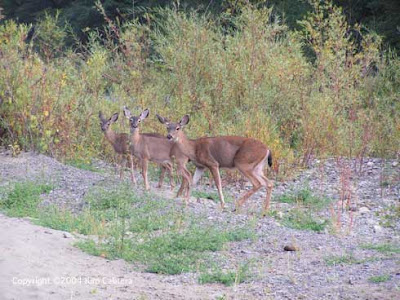

|
|
Hungry deer are a constant issue for foothill
gardeners. (Photo courtesy UC IPM)
|
It’s a constant question from foothill gardeners: What will deer NOT eat?
Find out during a free virtual workshop, “Living with Deer as a Foothill Gardener.”
Hosted by the UC Cooperative Extension Master Gardeners of Nevada County, this Zoom session is open to the public regardless of where they live. Set for 9 a.m. Saturday, Oct. 16, the workshop has no pre-registration; just click on the link and join in.
Deer rank among the most frustrating issues for foothill gardeners – and some Valley gardeners, too. These large mammals seem to always be hungry, and our gardens look so appetizing.
“Although there are no guarantees when gardening in deer country, there are ways to live with these browsers and have a lovely landscape and garden veggies as well,” say the master gardeners. “To learn more about managing deer in foothill gardens, join us to learn facts about the deer in our area and ways you can defend your gardens and landscape.”
Deer not only have big appetites; they can be just plain big. Mule deer, the most common species in the Sierra foothills and California’s only native deer species, can reach 6 feet tall and weigh 200 pounds. And they can jump!
Right now, deer are fattening up for the winter on acorns and other nutrient-rich foods. But they don’t care for lavender, rosemary or other pungent herbs. Think like a deer and, yes, you can redirect them away from your garden to native oaks and other more appropriate food sources.
More details and Zoom links (including passcode): https://ncmg.ucanr.org/ .
Comments
0 comments have been posted.Sacramento Digs Gardening to your inbox.
Sites We Like
Garden Checklist for week of May 5
Survey your garden after the May 4 rainstorm. Heavy rain and gusty winds can break the neck of large flowers such as roses. Also:
* Keep an eye on new transplants or seedlings; they could take a pounding from the rain.
* Watch out for powdery mildew. Warmth following moist conditions can cause this fungal disease to “bloom,” too. If you see a leaf that looks like it’s dusted with powdered sugar, snip it off.
* After the storm, start setting out tomato transplants, but wait on the peppers and eggplants (they want warmer nights). Pinch off any flowers on new transplants to make them concentrate on establishing roots instead of setting premature fruit.
* Trim dead flowers but not leaves from spring-flowering bulbs such as daffodils and tulips. Those leaves gather energy to create next year's flowers. Also, give the bulbs a fertilizer boost after bloom.
* Pinch chrysanthemums back to 12 inches for fall flowers. Cut old stems to the ground.
* Mulch around plants to conserve moisture and control weeds.
* From seed, plant beans, beets, cantaloupes, carrots, corn, cucumbers, melons, pumpkins, radishes and squash.
* Plant onion sets.
* In the flower garden, plant seeds for asters, cosmos, celosia, marigolds, salvia, sunflowers and zinnias. Transplant petunias, zinnias, geraniums and other summer bloomers.
* Plant perennials and dahlia tubers for summer bloom.
* Don’t wait; plant summer bulbs, such as gladiolus and tuberous begonias.
* Harvest cabbage, lettuce, peas and green onions.